Torpedo Control Disc
A Torpedo Control Disc was a British torpedo control instrument helpful in solving many torpedo-related problems and for setting a Torpedo Deflection Sight.[1] They appeared to assume the calculation tasks present in the Torpedo Directors being outmoded, and absent in the T.D.S.es which would be replacing them.[2]
The term is probably a generic one, but the British used it refer to a specific series of instruments identified by Mark which had modest differences from one another. They resembled simple Dumaresqs in a way, with no means of dialing on speed or heading for own ship (as own velocity has no part in calculating a Torpedo Deflection.
Mark I

The Mark I's design illustrates the fundamental properties of all Marks.[4]
- a baseplate graduated about its edge from 0 to 180 degrees green and red, fixed around a fore-aft line.
- a torpedo disc with an edge also graduated 0 to 180 degrees left and right could spin within the baseplate to align a pointer to the enemy's bearing. Lines drawn parallel to the line of sight were graduated in knots of speed-across, and possible shot curves for torpedoes were depicted. The Mark I's disc could record speeds-across of about 25 knots and had possible shot curves for two settings of the Mark II torpedo: 28 knots and 45 knots.
- an enemy bar was pivoted in the center of the device and pointed outward to the circular scales to record enemy inclination on the torpedo disc scale and relative heading on the baseplate scale. It was to be kept parallel to the enemy's course, not directed at his bearing. On the Mark I, the enemy bar was scaled between 5 and 25 knots.
- a enemy speed cursor could be slid along the enemy bar to record enemy speed in knots.
- a transparent scale pivoted on the enemy speed cursor. It had a reading edge (which was to be kept parallel to the lines on the torpedo disc) marked in range as well as range rate. A different scale was required for each torpedo setting.
The device was used as follows:
- rotate the torpedo disc to indicate the enemy bearing
- rotate the enemy bar to the apparent course of the enemy
- slide the enemy speed cursor to the proper speed.
The cursor would then indicate his speed-across on the torpedo disc and his "torpedo range rate" on the transparent scale where it cross the median line of the torpedo disc. This arrangement allows a Cross-cut to be performed, just as on a dumaresq, if external sources could supply trustworthy torpedo range rate and/or torpedo deflection.
Extreme firing range was recorded by adding or subtracting the figure where the range scale intersects the possible shot curve for the torpedo in use from the maximum range of the torpedo. If the enemy cursor were outside the curve, you were within range by the figure on the range scale, and if the cursor were within the curve, you were that many yards beyond of extreme range.
Mark II
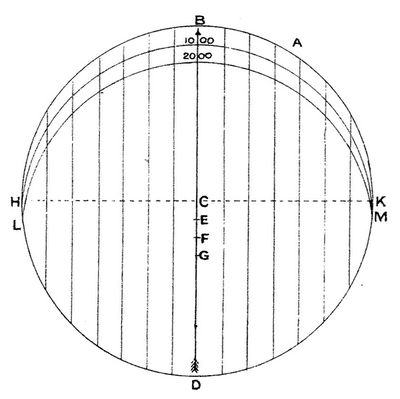

The Mark II disc was intended for hand-held use in cruisers and destroyers, and had a wooden handle to emphasise the point.[7] However, it also did away with the enemy speed cursor of the Mark I, requiring the operator to use his eye when positioning the scale.
The Mark II discs increased the supported enemy speeds to 28 knots.[8]
These discs were supplied by mid 1918.
The table below indicates which were etched for the Extended Range "E.R." or the new "Medium" range speed setting for each torpedo.
| Torpedo Control Discs Mark II Supplied by mid-1918[9] | |||||
|---|---|---|---|---|---|
| Stamp No. | for Torpedo Mark | Ship | Number Supplied | Medium? | E.R.? |
| T. 135 | 21-in II-II**** E.R. 3 | Destroyer Depot Ships | 1 for every 4 T.B.D.s attached | Yes | No |
| T. 136 | 21-in II***** & IV | Destroyer Depot Ships | 1 for every 4 T.B.D.s attached | Yes | No |
| T. 132 | 21-in II-II**** | Destroyers | 2 per ship | Yes | No |
| T. 135 | 21-in II-II**** E.R. 3 | Destroyers | 2 per ship | Yes | No |
| T. 136 | 21-in II***** & IV | Destroyers | 2 per ship | Yes | No |
| T. 138 | 21-in I-I* | Destroyers | 2 per ship | Yes | No |
| T. 139 | 18-in VII-VII**** | Cruisers, Light Cruisers, and Destroyers | 2 per ship | Yes | No |
| T. 140 | 18-in VII**-VIIIIII E.R. 3 | Cruisers, Light Cruisers, and Destroyers | 2 per ship | No | Yes |
| T. 151 | 21-in II-II**** E.R. 3 | Light Cruisers | 2 per ship | Yes | Yes |
| T. 152 | 21-in II***** & IV | Light Cruisers | 2 per ship | Yes | Yes |
| T. 139 | 18-in VII-VII**** | K class submarines | 1 per sub | Yes | No |
| Torpedo Control Discs Mark II Supplied by mid-1919[10] | |||||
|---|---|---|---|---|---|
| Stamp No. | for Torpedo Mark | Notes | |||
| T. 211 | 21-in II-II***** | 35 knot, 6,000 yard | |||
In mid-1920, it was further specified that only light cruisers equipped with 21-in Mark II to Mark II***** torpedoes would receive T. 211 discs, each receiving two of them, in boxes.[11]
Early in 1923, all Mark II-II**** torpedoes had their low speed performance downgraded to 23 knots to 13,000 yards – 1,000 yards less than previously. It was decided to punt on providing new defection discs for Mark II T.C.Ds. carried in ships of the Iron Duke and King George V classes, as well as H.M.S. Thunderer, though the Mark III* T.C.Ds. did receive a new disc. Users of the Mark III model were to employ disc T. 136 and to simply regard the maximum range as being 1,000 yards less.[12]
Mark II*
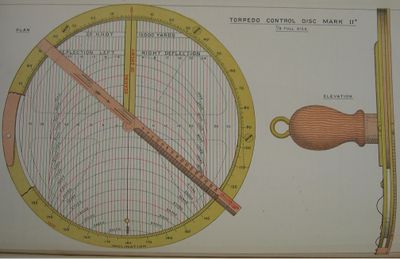
By 1918 or so, because so many variations of Mark II disc available, and the Mark IV* torpedoes now had four speed settings, a new, universal design was desired to reduce the number of discs needed in service.
It was to be a model similar to the T.C.D. Mark II supporting "Xylonite" discs 7.2 inches in diameter and 0.1 inches thick that could be slipped into the device which would bear the markings. A small index hole in this slip-in disc was engaged by a pin brought in by a leaf spring on the back of the frame to lock it into position. The Xlyonite disc was double-sided, so the four-speed torpedoes only required 2 slip-in discs, and the unused one kept safe in a leather wallet in the storage box (which stored 2 T.C.D.s).
The speed of enemy was increased to 35 knots as a precaution against faster enemies, which required the deflection lines to be 0.1 inch apart rather than 0.125 inches apart on the Mark II devices.
The markings were coloured on a white background for easy viewing, and the markings were cleaned up and slightly reworked so that enemy inclination was read off his head, and that inclination and deflection to left or right would be on the stated side of the device rather than reversed. The extreme firing range circles were graduated on both sides of the centre line so that one range graduation on each circle would always be visible.[14]
| Slip-in Discs for T.C.D. Mark II* in mid-1919[15] | |||||
|---|---|---|---|---|---|
| Stamp No. | for Torpedo Mark | Speed, Endurance side 1 |
Speed, Endurance side 2 | ||
| T. 196 | 21-in IV* | 25 knots, 15,000 yards | 29 knots, 11,000 yards | ||
| T. 197 | 21 knot, 18,000 yards | 35 knot, 6,000 yards | |||
| T. 209 | 21-in Mark V | 29 knot, 15,000 yards | 35 knot, 10,000 yards | ||
A re-ranging of some torpedoes required the issuance of new discs in 1921, graduated for maximum range using practice (not action) air charge as before. Those were as follows.
| Slip-in Discs for T.C.D. Mark II* in mid-1921[16] | |||||
|---|---|---|---|---|---|
| Stamp No. | for Torpedo Mark | Speed, Endurance side 1 |
Speed, Endurance side 2 | ||
| T. 245 | 21-in IV.R & IV*.R | 25 knots, 14,500 yards | 29 knots, 11,000 yards | ||
| T. 246 | 35 knot, 8,500 yards | N/A | |||
| T. 247 | 21-in Mark V | 25 knots, 14,500 yards | 29 knots, 12,000 yards | ||
| T. 248 | 35 knot, 9,500 yards | N/A | |||
Also in 1921, an additional Mark II* disc was allotted to each flotilla leader of the Mediterranean and Atlantic Fleets for use by the Lieutenant (T).
Other Parts
| Other Parts for T.C.D. Mark II*[17] | |
|---|---|
| Stamp No. | Component |
| T. 172 | wooden handle for the back face |
| T. 167 | pin the for spanners |
| T. 203 | base plate with distance piece and graduated ring |
| T. 167 | storage box |
Mark II**
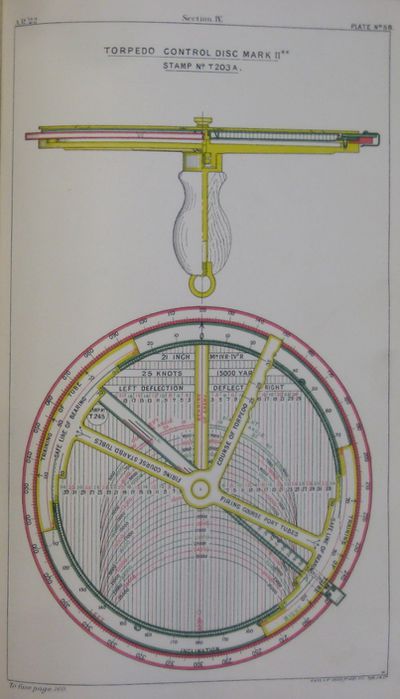
Around 1922, all Mark II* discs supplied to light cruisers, one of the two supplied to the destroyers, destroyer depot ships and "P" boats attached to Vernon, and two of the three discs in flotilla leaders were modified by adding a gyro compass ring and "firing course and safe bearing attachment". The new gadgets followed suggestions made the previous year for improved discs for flotilla leaders and were dubbed the T.C. Mark II**. They could be used as before, but supported new functions. Their additional instructions read as follows:[19]
- Set the "course of torpedo bar" so that the speed of torpedo in use cuts the same deflection line as that cut by "speed of enemy."
- read off at the end of the "course of torpedo" bar. Gyro course that torpedo should be fired on. Director angle.
- On either arc can be read off the firing course of the ship depending on the training of the tubes.
- On the inside part of the arc read off the safe limits for the line of bearing of the squadron or flotilla so that ships should not hit their next astern.
- The safe limits are shown for a turn in either direction, but the danger only exists when the next astern is on the engaged quarter.
- These arcs have been calculated as follows:
- With tubes trained 110° — the next astern should not be more than 20° on the quarter
- With tubes trained 90° — the next astern should not be more than 30° on the quarter
- With tubes trained 70° — the next astern should not be more than 40° on the quarter
In 1928, although the design of the devices was no longer deemed optimal, generous supplies in stock made it convenient to supply two Mark II** discs with deflection discs for 21-in Mark VII torpedoes to each London class cruiser, with an additional disc being supplied to those acting as flagships. Simultaneously, a new design for the disc (perhaps one designed by Lt. Commander John Cowie) was being considered in Vernon.[20]
Mark III
The Mark III was intended for use in armoured positions, and its baseplate could be rigidly secured.[21]
| Torpedo Control Discs Mark III Supplied by mid-1918[22] | |||||
|---|---|---|---|---|---|
| Stamp No. | for Torpedo Mark | Ship | Number Supplied | Medium? | E.R.? |
| T. 141 | 21-in II-II**** E.R. 3 | Battleships and Battlecruisers | 2 per ship | Yes | Yes |
| T. 142 | 21-in II***** & IV | Battleships and Battlecruisers | 2 per ship | Yes | Yes |
| T. 143 | 21-in Weymouth | Agincourt and Erin | 2 per ship | Yes | No |
| T. 144 | 18-in VI**-VII***** E.R. 3 | Battleships and Battlecruisers | 2 per ship | No | Yes |
| T. 145 | 18-in VII** H - VI**** H | Battleships and Battlecruisers | 2 per ship | Yes | No |
| Torpedo Control Discs Mark III Supplied by mid-1919[23] | |||||
|---|---|---|---|---|---|
| Stamp No. | for Torpedo Mark | Notes | |||
| T. 205 | 21-in IV* | 29/35 knot, double disc | |||
| T. 212 | 21-in II-II***** | 35 knot, 6,000 yards | |||
In mid-1920, it was specified that only battleships would receive the T. 212 discs, each to receive four of them, boxed.[24]
In 1923, the torpedomen in Queen Elizabeth noted that the new version of this disc was a great improvement over previous models, but they reported that the Director Angle scale should be engraved concentric with the rest of the disc to avoid confusion in reading off the gyro course of the torpedo.[25]
Early in 1923, all Mark II-II**** torpedoes had their low speed performance downgraded to 23 knots to 13,000 yards – 1,000 yards less than previously. It was decided to punt on providing new defection discs for Torpedo Control Disc Mark III carried in ships of the Iron Duke and King George V classes, as well as H.M.S. Thunderer, though the Mark III* T.C.Ds. did receive a new disc. Users of the Mark III model were to employ disc T. 141 and to simply regard the maximum range as being 1,000 yards less.[26]
Also in 1923, it was discovered that deflection disc T. 250 for use with Mark IV-IV*R torpedoes, had been drawn in error at a scale of 10 knots per inch, whereas the enemy bar was graduated at 8 knots. Somewhat grossly, users of these devices were told to file markings off the unused end of the enemy bar and to apply markings at 10 knots per inch, only to be used with disc T. 250, whereas the other end was for use with disc T. 142. One can imagine how easily an error in use could occur.[27]
By 1924, it was declared that no new Mark IIIs would be supplied, and that those extant instruments should be used only in emergency in the T.C.T.. Ships receiving new Mark III* discs were to return half their Mark III outfit, leaving only those emplaced in their T.C.Ts..[28]
Mark III*
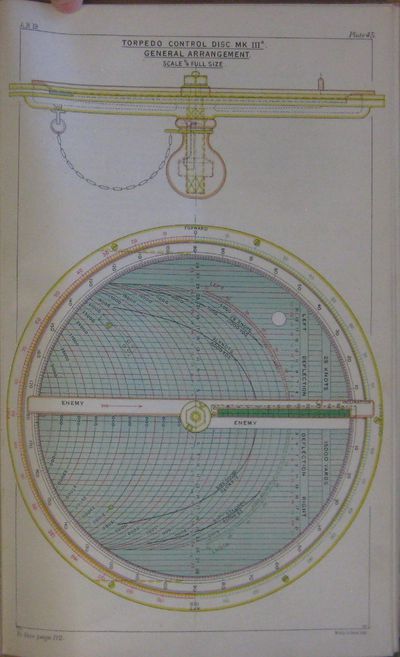
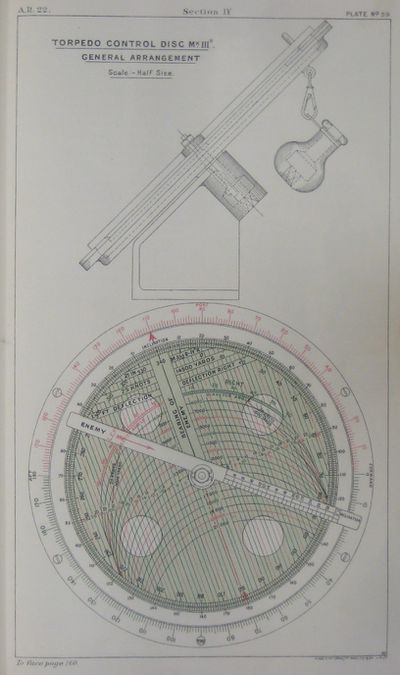
Similar to the Mark II/II*, the Mark III received a make-over in response to proposals from Resolution:
- a separate man with binoculars should just estimate inclination, as the ranges are too great to do this
- the Mark III was deemed too small to read easily. A 10 inch diameter would be better
- the disc had 2 speed settings now, and this is hard to read, especially when inclinations were not near 90 degrees
- deflection should be marked in single knots, not every 4 knots as now
- the "cyphers" showing thousands of yards are not needed.[31]
- the ranges should be written 3 times along the longer curves
- coloured lines on the enemy bar to facilitate use of Bell's Station Keeper should be omitted
- the arrow of the "Bearing of enemy" line should be continued to the outer edge of the disc so the bearing can be set accurately
- the pieces securing the enemy bar should be made of brass
- black curves might be added for alternative settings so that a different speed setting might be decided upon
These suggestions were taken into account in delivering a new design that also increased the enemy speed limit to 35 knots and added the use of the Xylonite slip-in discs as used in the Mark II* sight. This design was submitted to C-in-C, Grand Fleet and elicited this supplemental list of features from the Fleet Torpedo Committee:
- the binoculars for judging enemy inclination should be used by a separate man, and not fitted to the device in any manner
- the largest possible transparent window should be added to the enemy bar to help read the disc
- limiting enemy speed to 30 knots rather than 35 would permit better spacing of lines
- discs should be engraved with curves showing when possible shot range is the same for different torpedo settings
- discs should be as light as possible, usable by hand or when shipped in a socket
- the "upper part of the circle corresponding to the setting in use should be graduated in degrees for reading off the director angle."
The advice was taken together with a few final graphical improvements to create the Mark III* design. The Fleet Torpedo Committee's report had specified that brass should be used, but this would weigh 14 pounds. Duralumin was chosen as having sufficient resistance to corrosion if cared for with varnish and oil, and the device would weigh 4.25 pounds. The devices were to be kept oiled and boxed when not in use in order to ensure they lasted more than 3 years.
It was proposed in mid-1918 that these be allocated:[32]
- one to each battleship, battlecruiser and cruiser for use in primary control position
- four to Eagle
- six to each of the Admiral class
- one to Defiance and Actæon and two to Vernon for instruction
1919
| Slip-in Discs for T.C.D. Mark III* in mid-1919[33] | |||||
|---|---|---|---|---|---|
| for Torpedo Mark | Speed, Endurance side 1 |
Speed, Endurance side 2 | |||
| 21-in Mark II-II*** | 18 knots, 18,000 yards | 23 knots, 15,000 yards | |||
| 21-in Mark II**** | 19 knots, 18,000 yards | 24 knots, 15,000 yards | |||
| 21-in Mark IV-IV* | 25 knots, 15,000 yards | 29 knots, 11,000 yards | |||
| 21 knots, 18,000 yards | 35 knots, 6,000 yards | ||||
| 21-in Mark V | 29 knots, 15,000 yards | 35 knots, 10,000 yards | |||
1920
By mid 1920, the design was completed, and these were to replace the Mark III for future capital ship requirements. The deflection disc for the Mark V torpedo was no longer so certain, as the particulars of that torpedo's two settings were still a matter of debate. Also the range for the 35-knot speed of the IV/IV* torpedo was then the subject of experiments aimed at increasing it from 6,000 yards. The Mark II variants had some small differences, but these were seen as slight and it was deemed acceptable to mean them for a common pair of discs.
| Slip-in Deflection Discs for T.C.D. Mark III* in mid-1920[34] | |||||
|---|---|---|---|---|---|
| for Torpedo Mark | Speed, Endurance side 1 |
Speed, Endurance side 2 | |||
| 21-in Mark II***-II***** | 35 knots, 6,000 yards | 18.5 knots, 18,000 yards | |||
| 23.5 knots, 15,000 yards | blank | ||||
| 21-in Mark IV-IV* | 25 knots, 15,000 yards | 29 knots, 11,000 yards | |||
| 21 knots, 18,000 yards | 35 knots, ? yards | ||||
| 21-in Mark V | to be determined | to be determined | |||
1921
A celluloid gyrocompass ring was incorporated into the design, and difficulties in manufacture of the rings had been overcome by use of die-casting.
| Slip-in Deflection Discs for T.C.D. Mark III* in mid-1921[35] | |||
|---|---|---|---|
| for Torpedo Mark | Disc Patt. # | Speed, Endurance side 1 |
Speed, Endurance side 2 |
| 21-in Mark IVR and IV*R | T.227 | 29 knots, 11,000 yards | 25 knots, 14,000 yards |
| T.228 | 35 knots, 8.500 yards | blank | |
| 21-in Mark V | T.249 | 29 knots, 12,000 yards | 25 knots, 14,500 yards |
| T.230 | 25 knots, 14,500 yards | 35 knots, 9,500 yards | |
| 21-in Mark II-II***** | T.226 | 23-24 knots, 14,000 yards | 35 knots, 6,00 yards |
1923
Early in 1923, all Mark II-II**** torpedoes had their low speed performance downgraded to 23 knots to 13,000 yards – 1,000 yards less than previously. This required issuance of a new deflection disc for Torpedo Control Disc Mark III* numbered T. 226A to all ships carrying these weapons, meaning ships of the Iron Duke and King George V classes, as well as H.M.S. Thunderer.[36]
All capital ships with this instrument were to receive an additional, fourth one to permit one to be available in each of the Primary Control Positions and in each Conning Tower. Hood was excepted from this order, as she already had four discs.[37]
See Also
Footnotes
- ↑ Handbook of Torpedo Control, 1916. p. 27.
- ↑ Annual Report of the Torpedo School, 1915. pp. 60-61. Annual Report of the Torpedo School, 1916, p. 25.
- ↑ Handbook of Torpedo Control, 1916. Plate 15.
- ↑ Handbook of Torpedo Control, 1916. pp. 27-28.
- ↑ Handbook of Torpedo Control, 1916. Plate 16.
- ↑ Handbook of Torpedo Control, 1916. Plate 17.
- ↑ Handbook of Torpedo Control, 1916. p. 28.
- ↑ Annual Report of the Torpedo School, 1918. p. 163, points (c & d).
- ↑ Annual Report of the Torpedo School, 1917. pp. 194-195.
- ↑ Annual Report of the Torpedo School, 1918. p. 162.
- ↑ Annual Report of the Torpedo School, 1919. p. 114.
- ↑ Annual Report of the Torpedo School, 1923. p. 126.
- ↑ Annual Report of the Torpedo School, 1918. Plate 116.
- ↑ Annual Report of the Torpedo School, 1918. p. 163.
- ↑ Annual Report of the Torpedo School, 1918. p. 164.
- ↑ Annual Report of the Torpedo School, 1921. p. 142.
- ↑ Annual Report of the Torpedo School, 1918. p. 164.
- ↑ Annual Report of the Torpedo School, 1928. Plate 58.
- ↑ Annual Report of the Torpedo School, 1922. p. 160.
- ↑ Annual Report of the Torpedo School, 1928. p. 51.
- ↑ Handbook of Torpedo Control, 1916. p. 28.
- ↑ Annual Report of the Torpedo School, 1917. pp. 194-195.
- ↑ Annual Report of the Torpedo School, 1918. p. 162.
- ↑ Annual Report of the Torpedo School, 1919. p. 114.
- ↑ Annual Report of the Torpedo School, 1923. p. 158.
- ↑ Annual Report of the Torpedo School, 1923. p. 126.
- ↑ Annual Report of the Torpedo School, 1923. p. 126.
- ↑ Annual Report of the Torpedo School, 1924. p. 134.
- ↑ Annual Report of the Torpedo School, 1919. Plate 45.
- ↑ Annual Report of the Torpedo School, 1928. Plate 59.
- ↑ I am guessing this means "10,000" rather than "10". Vernon disagreed with this suggestion, as they felt confusion of range and deflection might result.
- ↑ Annual Report of the Torpedo School, 1918. p. 165.
- ↑ Annual Report of the Torpedo School, 1919. p. 113.
- ↑ Annual Report of the Torpedo School, 1919. p. 113.
- ↑ Annual Report of the Torpedo School, 1921. p. 143.
- ↑ Annual Report of the Torpedo School, 1923. p. 126.
- ↑ Annual Report of the Torpedo School, 1923. p. 126.
Bibliography
- Admiralty, Gunnery Branch (1917). Handbook of Torpedo Control, 1916. C.B. 302. Copy No. 141 at The National Archives. ADM 186/381.
- H.M.S. Vernon. Annual Report of the Torpedo School, 1916. Originally C.B. 1329. Copy 4 at The National Archives. ADM 189/36.
- H.M.S. Vernon. Annual Report of the Torpedo School, 1917. Originally C.B. 1474. Copy 7 at The National Archives. ADM 189/37.
- H.M.S. Vernon. Annual Report of the Torpedo School, 1918. C.B. 1527. Copy 143 at The National Archives. ADM 189/38.